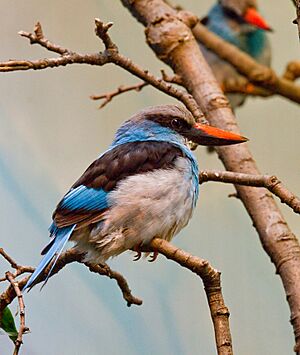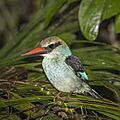Blue-breasted kingfisher facts for kids
Quick facts for kids Blue-breasted kingfisher |
|
|---|---|
 |
|
| Taken at the Cincinnati Zoo | |
| Conservation status | |
| Scientific classification | |
| Genus: |
Halcyon
|
| Species: |
malimbica
|
| Subspecies | |
|
|
The blue-breasted kingfisher (its scientific name is Halcyon malimbica) is a beautiful bird found all over central Africa. It's a type of tree kingfisher, which means it usually lives in wooded areas. These birds mostly stay in one place, but they might move to wetter spots during the dry season.
Contents
What Does the Blue-breasted Kingfisher Look Like?
This is a fairly large kingfisher, growing to about 25 centimeters (10 inches) long. Adult birds have a bright blue head, back, wings, and tail. Their belly is white, but they have a striking blue band across their chest. Their shoulders are black.
The blue-breasted kingfisher has a large beak. The top part of its beak is red, and the bottom part is black. Its legs are a bright red color. When it flies, it moves very fast and in a straight line.
Sounds and Differences
Both male and female blue-breasted kingfishers look quite similar. However, young birds are not as brightly colored as the adults. This bird is known for being quite noisy! Its call sounds like a series of whistles, often described as pu-pu-pu-pu-ku-ku-ku-ku.
Where Do Blue-breasted Kingfishers Live?
You can find the blue-breasted kingfisher in many different types of forests and woodlands. They like places with lots of trees. These birds are quite shy and prefer to perch quietly in shady spots while they look for food. They also protect their own territory.
What Do They Eat?
Blue-breasted kingfishers are skilled hunters. They mainly eat large insects and other small creatures like arthropods. They also enjoy eating fish and frogs. Sometimes, they will even eat the fruit from Oil Palm trees.
Nesting and Eggs
When a blue-breasted kingfisher wants to show off, it spreads its wings wide. This shows off the white feathers on the underside of its wings. For their nest, they dig a hole inside a termite nest found in a tree. Usually, a female kingfisher will lay a single clutch of two round, white eggs.
Types of Blue-breasted Kingfishers
There are a few different types, or subspecies, of the blue-breasted kingfisher. They are found in slightly different parts of Africa:
- H. m. malimbica: Lives in woodlands from Cameroon to Uganda and Zambia.
- H. m. forbesi: Found from Sierra Leone to eastern Nigeria and a small part of western Cameroon, including Bioko Island.
- H. m. torquata: Lives in southern Senegambia and Guinea-Bissau, reaching into western Mali.
- H. m. dryas: Found on Príncipe Island and used to be on São Tomé Island, both part of São Tomé and Príncipe.
Images for kids
-
H. m. dryas
São Tomé and Príncipe




